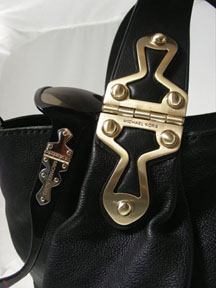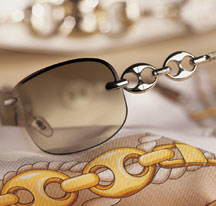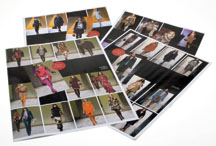RELATED CONTENT

 |
| PHOTO: ANNIE GALLGHER/BLACK BOX STUDIOS |
By Deirdre Carroll
Associate Editor
NEW YORK--Twenty years of technology, design innovation and manufacturing shifts have had a tremendous impact on the process of how eyewear and sunwear is developed. The emergence of eyewear brands--designer licenses, consumer brands and original house collections--has become increasingly more important as eyewear has become a global business. The need to develop and translate a brand's image and philosophy into the eyewear category to appeal to today's diverse consumers is now an integral part of the eyewear design process.
 Vision Monday spoke with several product development industry leaders to track the ascension of brands and their expansion into the optical industry over the last two decades to gain a better understanding of the current climate and about how they define a brand?s identity, achieve brand distinction and identify new technologies.
Vision Monday spoke with several product development industry leaders to track the ascension of brands and their expansion into the optical industry over the last two decades to gain a better understanding of the current climate and about how they define a brand?s identity, achieve brand distinction and identify new technologies.
Then and Now
Twenty years is a lifetime in the worlds of fashion and technology advancement, and as such, a number of significant developments in the eyewear industry can be attributed to the progress of time.
One of the most fundamental developments is the emergence of eyewear as a fashion accessory causing a proliferation of new and established fashion brands to enter the market.
"Eyewear has transitioned from a functional device to an important fashion accessory in the past two decades, and especially in the past 10 years," stated Claudio Gottardi, CEO of Safilo USA.
"I think we were such an unusual category, something that most design houses couldn't really embrace and I think it was also very technologically intimidating,? explained Leslie Muller, senior director of design for Marchon. "Eyeglasses are a class one medical device rated by the FDA, so there's this sort of intimidation factor, but now I think everyone's a lot more educated, savvier."
"Technological regulation is important for people who wear prescriptions but it's the fashion industry that has changed a lot," said Alessandro Beccarini, international product development director of Luxottica. "Each year, we present approximately 45 new styles to market for each brand. Some are fashion, some are classic, some are technological but even 10 years ago there were not as many brands and maybe only 10 to 15 styles in each collection."
Colin Baden, president of Oakley, agreed that the options have increased exponentially. "In 2000, we had six models that were all similar. They were for the same customer with the same character. Fast forward a couple of years and we now have clear segmentation to appeal to specific consumer groups while still falling under that same Oakley character and story."
"Twenty years ago there wasn't that much competition," said Muller. "Back in the day, I was at Bausch & Lomb and you made the frame, put the Ray Ban name on it and you were done. But now, there is so much competition in the market that we are really partnering strongly with our licensors to completely absorb and understand their DNA to make every brand look right."
"Brand names used to be enough to create a point of difference to consumers," added David Duralde, vice president of creative development of the Kenmark Group. "Brand names make people look and now eyewear designers have more of a responsibility to the overall concept and to design frames that distinguish each brand. They meet with the brands to create a collection that speaks the brand message to consumers and so it has a cohesive look."
"Not until the last decade, did our brands truly begin to pay attention to the eyewear bearing their logos. It was basically a licensing and financial agreement," said Gottardi. "As the luxury business has grown, the brands are much more involved then ever before in every aspect of their eyewear collections."
Over time, brands have begun to focus on a specific audience and demographic
"REM signed its first licensed brand, Converse, 20 years ago. In those days brands were a crutch to leverage for retail shelf space and address market opportunities, but were not necessarily focused on making certain the products harmoniously matched the brand?s qualities. Over the past two decades that has changed radically," said Mike Hundert, president and CEO of REM Eyewear. "Brands have become more marketing savvy and focused, more narrowly defined to specific demographic audiences. And brand extensions, such as eyewear, have learned the value of the seamless reflection of each brand's specific approach and aesthetics. The result is far better, and more appropriately designed, eyewear.
Giancarla Agnoli, senior vice president of design for of Marchon agreed, "It gives you an added dimension outside of the eyewear industry by being connected to designer houses and their collections of jewelry, accessories and fashion. It widens the horizon and with more people involved it naturally leads to innovation."
 |
|
| (Above) Hardware from Michael Kors' Joplin handbag gets re-interpreted into the Joplin hinge in the Michael Kors collection from Marchon. (Right) The iconic Gucci marine chain makes an appearance on the temple for Safilo's Gucci collection of eyewear.
|
 |
Defining a Brand
As more and more brands have exploded onto the market the need to create clearly established identities and brand values has become increasingly important.
"The demand for product differentiation and brand appropriate products has made the design processes far more creative within brand borders established by licensors," stated Hundert. "It has required more creative thinking and a far more elaborate and lengthy process in the design and development of eyewear. And it is a more collaborative process today, in which we work closely with the brand's creative leaders to ensure connectivity with the brand's essence and the expectations of the brand's loyal customers."
For a consumer brand like Oakley, which had to build its reputation from the ground up, defining its brand identity was even that much more crucial to its success.
"We started as a handgrip company and then branched into goggles because of their tie in with motocross," explained Baden. "When you enter into a new category you have to invent the performance metric. We had to make sure it could stand up against the competition and then wrap it in art. Since we have a unique performance story, we evolved a design language to wrap our design story and started an evolution in goggles that every consumer can understand and embrace.
"It's was the same for the eyewear market. We believed frame technology had reached a certain point and felt we could apply new technology. We saw opportunities to improve lens geometry, to improve optics, lens materials, the types of coatings to use light and improve performance with water, opportunities in fit and comfort, as well as impact protection and periphery protection. In essence, we created sport performance eyewear and put a mark where nothing else existed. Other brands followed to some degree or another," Baden concluded.
 |
| The iconic gromets from the Converse Chuck Taylor decorate the temples of a REM frame |
.
Still even established brands have to make sure their brand philosophy remains true when they enter into the eyewear category.
"Cole Haan is not a licensing company, they own most of their accessory categories, so it was very important to them when we signed our agreement that we capture some of the old world hand attention to detail they are know for," said Peter Friedfeld, executive vice president of ClearVision Optical. "They are very much about hand-crafted luxury, artisan craftsmanship and innovation wrapped in beauty."
The Importance of Synergy
Fr licensed fashion brands another notable difference between the past 20and the 20 pesent how importan it has become for the eyewear to mirror the overall design direction for the brand as a whole.
"Since the eyewear has become a true fashiond accessory and is viewed as such it has to reflect the vision of the brand and it's DNA. The customer and the fashion houses bring their knowledge to the table leading to constant innovation," said Agnoli.
"We used to design in a silo, we were designing in a bubble," agreed Mark Ginsberg, senior vice president for designer brands for Marchon. "It was all about the eyewear and we were designing beautiful eyewear that hopefully integrated back to the brand. Now we design in a collaborative, branded team that is driven by the licensor because now there is a lifestyle approach which wasn't part of the process years ago. In the past, a big apparel manufacturer was either known for furs or coats or ready-to-wear, now everybody wants to be a lifestyle. The synergy, the expectation now that they have is that we should all be speaking from the same platform, that we should have the same vocabulary, that it should be the same pantone color that's across all the categories.That's pushing us to come up with what needs to be done in terms of complying."
"The eyewear category has become an increasingly much more important extension of a brand's essence," Gottardi said. Eyewear now goes through the same stringent approval process as a designer's clothing, bags and shoe collections--which wasn't always the case.
"In the last several years, there has been much more synergy and collaboration with our brands so that the eyewear now has a direct correlation back to the brand's other accessories categories incorporating intricate buckles, charms, stones, quilted patterns, woven designs, and even decorative insects like in Gucci for example, into the design of the glasses. While the process has become increasingly more difficult and the technology much more advanced due to the intricacies involved--it is absolutely worth it. We now have a much better product to sell; a product that tells a story and is part of a story steeped in brand consciousness," Gottardi said.
"Brands have a very unique and distinctive design vocabulary that reflects the overall brand message," added Duralde. "By translating details and motifs into eyewear and sunwear we help to unify a collection through logo applications, jeweled decor, unique hinges and custom colorations."
"With the interest in designer brands at an all time high, consumers are much more focused on the design nuances of a frame then ever before. We've been working very closely with our designer brands to make sure that there is design synergy and a seamless consistency with each of our eyewear collections," confirmed Gottardi. "They are providing us with much more design inspiration--icons, color direction, etc.--and there is much more collaboration between our designers and theirs, as well as both companies' marketing and public relations departments and sales divisions. We are truly considered part of their organizations now and [are] better and more successful business partners as a result."
"Luxottica is lucky in that we have the chance to work with the best designers in the world," said Beccarini. "It is no longer just our work but a cooperation with these designers, like Miuccia Prada and Dolce & Gabbana; sharing our vision with their vision.
We receive in-put directly from the designers and details that are going to be used in fashion shows in order to collaborate and now we have several ways of working."
"To me that's the biggest change," concluded Ginsberg. "It is so collaborative and there is this element of communication, there is no 'us and 'them' anymore. It's a 'we' kind of approach. That's different and that's compelling."
Technology Today
Much of the detail work that keeps these brands in sync with the product developers is in no small part due to the continuing advancement of technology in eyewear design and manufacturing, often borrowed from other industries.
"Technology has broadened the palette of design opportunity. And the need for differentiation has pushed and encouraged the creativity of engineers to collaborate with designers, resulting in perpetual innovation," stated REM's Hundert.
"Connecting to a brand's DNA has led us to study the creative and engineering processes of other industries to transfer and interpret unique brand attributes to the eyewear category. To match design elements of a brand's most renowned products, many manufacturing techniques, such as the use of lasers for etching, and metal casting for creating intricate components have been borrowed from other industries and reinterpreted into the manufacturing processes of eyewear. In the perpetual push for higher quality, coatings and coloring techniques have also evolved," he said.
"For example, our Converse brand is well known for its 'vulcanized' shoes, in which canvas is bonded to rubber. That attribute led us to explore, engineer, and implement a way to 'vulcanize' rubber to a carbon graphite material," explained Hundert.
"There is this cross-fertilization going on at a rapid speed," agreed Ginsberg. "It's happening at an industrial design level, at a creative level. It is at a branding and fashion level and the designers will show me something in a completely unrelated category, whether it is a cell phone or a really cool piece of jewelry or hardware, and it will somehow morph itself into a technology that applies itself to eyewear, which we never would have though of that, even 10 years ago."
"We use technology to enhance a medical device to offer performance and style to consumers. Design and technology innovations have allowed eyewear designers to take from other disciplines such as jewelry making, plastic manufacturing, new lens colorations, lens manufacturing," confirmed Duralde. "We create specific relationships with factories to educate them on the themes, goals and perspective of the brand. Technology has improved the manufacturing process--allows factories to produce frames in mass levels that look good and are high quality. The mass production allows more time for details such as threading and beading to be hand applied to each frame. The craftsmanship element to make frames more intricate with advancing colorations, and refinement of product through technology makes consumers desire more in their eyewear. Consumers are embracing the technology as well and are more demanding in what they expect in the designs and quality of their eyewear."
 |
"For example, in Coach we are now going into the jewelry category, there are lots of technologies in jewelry, whether its cloisonne, enameling, engraving, embossing, that easily transfer to a metal temple or a metal embellishment on a temple," explained Ginsberg.
"And we are looking into new ways of casting metal for this more intricate hardware that's never really been done," added Marchon's Muller. "Now we are doing more and more of it to capture all sorts of details that you'd get in jewelry. Once you get through that you have to test it and make sure it isn't going to fall apart, or scratch easily and there are a lot of quality control issues but more and more I'd say that as a whole our factories and Marchon is supporting these blue sky ideas, supporting us from all sort of technical areas."
"At Luxottica, we're pushing new materials experimenting with new technologies and creative ways of using existing materials," stated Maristella Brentani, vice president of product development for Luxottica. "In acetates, we've gone from one tone to double to triple, sculpting, different layers of colors, different laminations. Things like lace imbedded or integrating feathers. We are doing continuous research with lens manufacturers which applies strongly to the men's and sports segment, but women as well as they try to protect their eyes."
"In the factories, there are lots of new techniques now with zyl, with the lamination of zyls, it used to be you sandwich three colors and when you carved it, you got a different color on the front," described Ginsberg. "Now they're punching the color through, they're embedding other materials, they're lacquering, they're forming it different, they're infusing a marbleized opalescence into it, and there are sparkles. There's gold, there's glitter, there's charms."
"Technology is more and more transparent in eyewear. It is well integrated into the frames," said Kenmark's Duralde. "Fashion-forward trends are created through technology. It is the quiet force behind the fashion expression of a frame. Technology used to be the frame--now it has evolved in the background but creates attributes to make the frame look more innovative in design."
The Bottom Line
All this design and technology innovation begs the question: What's the price tag and is it all worth it?
"We need to keep investing in technology and the use of new materials and new colors," said Luxottica's Brentani. "For example, in Polo, we had to be true to the brand but at the same time re-invent it. We invested in technology and machinery to re-design the tubular frames from the 1960s so they are now much more lightweight. We continue to invest in cost-effective ways to make it new and creative. Not the most expensive way but the way that will keep us profitable and we're looking at what is going on in the industry for fresh ideas on how to do this."
"Because eyewear designers have the resources and knowledge of manufacturing product, the process of working with brands and licensors is more streamlined," said Kenmark's Duralde. "Designers flush out ideas with brands then go to the factories ready with concepts, materials and drawings for product that articulate the brand message."
Marchon's Agnoli, "We start by entering the world of the given brand before you even go to the drawing board. The better you understand the philosophy the easier and more cost effective it becomes to translate it into eyewear. You also need to understand the engineering side. Brainstorming with engineering and the better you are able to communicate the need to translate the better the result."
"We have no choice [but] to make sizeable investments in our brands," stated Gottardi. "Because we are such a large player in the industry, we are of course able to get supplier discounts on specific materials that we order in bulk such as black and tortoise acetate, for example, but the reality is that there are unique needs for every brand. We must develop custom colors and unique design details that we must invest in to keep the brand?s identity strong. We make allowances for this in our pricing structure."
"We have to manage a budget as well as design, so we do balance it. Licensors understand that because they are doing the same thing in all of their categories," concluded Ginsberg. "They don't ask us for crazy, unrealistic stuff, but they do want to push the envelope and they do usually ask for special things for runway. If it is a real designer brand, we'll hand make 10 of them and they'll put them in their show and if it's successful we'll figure out how to translate and re-interpret it for production so that it makes sense. We do first and foremost keep it a business. There's always a budget up front, whether it's a cost budget, a production budget, or a capacity claim so we kind of work within the confines of were we can be. We didn?t do that years ago. We weren't as smart, we are much smarter now."